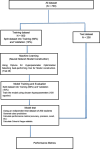Artificial intelligence in suicide prevention: Utilizing deep learning approach for early detection
- PMID: 39898082
- PMCID: PMC11784676
- DOI: 10.4103/ipj.ipj_20_24
Artificial intelligence in suicide prevention: Utilizing deep learning approach for early detection
Abstract
Background: Suicide among students is increasing in India and is a matter of grave concern. Early identification of students contemplating suicide would facilitate emergency intervention and may save precious lives.
Aim: Our primary objective was to construct an artificial intelligence (AI) model employing an artificial neural network (ANN) architecture to predict students at risk of suicidal tendencies. This initiative was prompted by the necessity to implement a proactive and technologically driven strategy for identifying competitive exam-bound students facing heightened vulnerability. The aim was to facilitate timely interventions aimed at reducing the risk of self-harm.
Materials and methods: An AI model utilizing ANNs is devised for suicide risk prediction among exam-stressed students. A 33-feature input layer is curated based on literature and expert insights, with binary features assigned weighted values. A rigorous hyperparameter optimization approach using the Optuna library to select the most effective neural network model. Ridge regression was used to determine bias or variance in the dataset. Training and testing of the model are conducted using fictional and simulated profiles, respectively, and model performance is assessed through statistical metrics and the Cohen's Kappa coefficient, benchmarked against expert evaluations.
Result: The AI model demonstrates exceptional predictive capabilities for suicide risk assessment among competitive exam students. Quantitative Metrics: The model's accuracy of 98% aligns predictions with outcomes, distinguishing risk categories. Precision at 100% identifies cases within predicted risks, minimizing false positives. A recall of 97% identifies true risk cases, highlighting sensitivity. F1 Score: The model's F1 score of 98% balances precision and recall, indicating overall performance. Cohen's Kappa: With a coefficient of 1.00, the model's substantial agreement with experts underscores its consistent classifications.
Conclusion: The study introduces an AI model utilizing ANNs for suicide risk prediction among stressed students. High precision, recall, and accuracy align with expert evaluations, highlighting its promise for timely risk identification. The model's efficiency in evaluating large populations swiftly indicates its clinical potential. Refinement and real-world validation remain future considerations.
Keywords: Artificial intelligence; artificial neural network; deep learning; machine learning; suicide prediction.
Copyright: © 2024 Industrial Psychiatry Journal.
Conflict of interest statement
There are no conflicts of interest.
Figures
Similar articles
-
Leveraging code-free deep learning for pill recognition in clinical settings: A multicenter, real-world study of performance across multiple platforms.Artif Intell Med. 2024 Apr;150:102844. doi: 10.1016/j.artmed.2024.102844. Epub 2024 Mar 13. Artif Intell Med. 2024. PMID: 38553153
-
InsightSleepNet: the interpretable and uncertainty-aware deep learning network for sleep staging using continuous Photoplethysmography.BMC Med Inform Decis Mak. 2024 Feb 14;24(1):50. doi: 10.1186/s12911-024-02437-y. BMC Med Inform Decis Mak. 2024. PMID: 38355559 Free PMC article.
-
Enhanced osteoporotic fracture prediction in postmenopausal women using Bayesian optimization of machine learning models with genetic risk score.J Bone Miner Res. 2024 May 2;39(4):462-472. doi: 10.1093/jbmr/zjae025. J Bone Miner Res. 2024. PMID: 38477741 Free PMC article.
-
Predicting Deep Venous Thrombosis Using Artificial Intelligence: A Clinical Data Approach.Bioengineering (Basel). 2024 Oct 25;11(11):1067. doi: 10.3390/bioengineering11111067. Bioengineering (Basel). 2024. PMID: 39593727 Free PMC article. Review.
-
Artificial Intelligence Applications to Measure Food and Nutrient Intakes: Scoping Review.J Med Internet Res. 2024 Nov 28;26:e54557. doi: 10.2196/54557. J Med Internet Res. 2024. PMID: 39608003 Free PMC article.
Cited by
-
Exploring the experiences and perceptions of nursing students in utilizing artificial intelligence: a descriptive phenomenological study.BMC Nurs. 2025 Jul 1;24(1):740. doi: 10.1186/s12912-025-03392-3. BMC Nurs. 2025. PMID: 40598077 Free PMC article.
References
-
- Yadav S, Srivastava SK. Correlational study of academic stress and suicidal ideation among students. Indian J Public Health Res Dev. 2020;11:56–61.
-
- Nebhinani N, Kuppili PP, Kapoor V, Singhai K, Mamta Reflections of medical students on causes of rising suicide among medical aspirants. J Indian Assoc Child Adolesc Ment Health. 2020;16:102–8.
LinkOut - more resources
Full Text Sources



